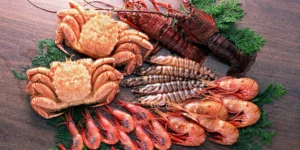Seafood is a rich source of nutrients that are both healthy and delicious. It is well-known that seafood has plenty of health benefits that are applicable to children and adults. Yet, many parents are wondering if it is safe to include seafood in their children’s diet. The answer is yes. Of course, there are certain quantities that need to be respected, there are certain risks that can appear along the way. Since you are being informed on this topic, there’s nothing you should be worried about.
Starting with the very beginning, seafood is considered a stepping stone to a complete, healthy eating plan. This is the reason why doctors recommend consuming seafood for a proper development of children, especially for pregnant women. Seafood contains Omega-3 fatty acids that positively influence the body. Besides fatty acids, seafood is rich in vitamins, minerals, and proteins. The one thing that parents fear most about consuming seafood or including it into the children’s diet would be the fact that it is can be allergenic to some. Yet, the American Academy of Pediatrics recommends consuming seafood regularly. Children aged between 0 and 6 years old should eat about 85 grams of seafood in a meal. For children aged between 6 and 12 years old, the amount of seafood recommended raises to 130 grams. See a list of information related to seafood that will help you decide how your children’s diet will look like in the future:
Seafood is easy to cook

It is pretty obvious that being a mom is complicated and you don’t always have enough time to cook sophisticated meals for your kids, but that doesn’t mean that you can’t cook healthy, quick meals. Seafood has the great benefit of being included in many fast, delicious recipes. Most types of seafood you can find at Crab Dynasty can be grilled or included in recipes that your kids normally like. Grilling won’t take you longer than 5-6 minutes, which is very convenient for a healthy, nutrient-filled lunch. Take as an example:
- Salmon – you can season salmon as you desire, then glaze it with unsweetened pomegranate molasses; it can be grilled over medium-low heat for about 5 minutes
- Tuna – tuna is best for quick meals because it can be seasoned and marinated long before grilling and then you can throw it on the grill and keep it there 3 minutes per side
- Swordfish – season can be done liberally, and it can be served with cherry tomatoes, grilled corn, and olive oil; 5 minutes is all it takes
- Mahi-mahi – this is a more exotic type of seafood and it can be served with fruits like mango or pineapple; you should grill mahi-mahi at least 5 minutes over medium heat
- Red snapper – be careful to clean and scale the fish properly, add 3 diagonal slits to the skin of the fish, fill them with lemon and then season with fresh herbs; grill over high heat for 5 minutes per side
- Shrimp – shrimp can also be marinated before grilling; use herbs, lemon, and garlic and make sure you grill shrimp over high heat; 3-4 minutes per side should be enough
You can find plenty of recipes on the Internet that do not require grilling as well. Depending on your little ones’ preferences in terms of food, you should choose recipes that they would like to try. If your children are reluctant to eat seafood, try including them into dishes that they usually eat. For instance, go for seafood pasta or seafood pizza. Usual recipes are attractive for kids and they might be willing to try something new if they are at least one bit familiar with the way the food looks.
When can I include seafood in the babies’ diet?

Seafood is part of the list of foods that cause allergies, and this is the reason why you need to be careful when including it into your children’s diet for the very first time. Most allergies are caused by the protein called tropomyosin, which can be found in seafood. Yet, the lowest risk is represented by boiled seafood. Including it in a baby’s diet should be done after the child reaches 1 year old, when the risk of allergies is visibly reduced. Since it is a new type of food, you can ask your pediatrician about your new meal plan and follow the 4-day wait rule. This rule involves the diversification of a baby’s diet implying a number of days to test out the effects of newly-introduced foods. Younger babies are more prone to digestive disorders and allergic reactions, so opt for seafood after your pediatrician mentioned it is safe to do so.
The health benefits explained
Seafood is an extraordinary source of:
- Vitamin A, B12, B3, B6, E
- Protein
- Phosphorus
- Zinc
- Magnesium
- Omega-3
- Selenium
All the nutrients existent in seafood are helping children to develop in a healthy way. Starting with the blood circulation system, seafood can offer a person the daily necessary amount of iron. Iron is the one nutrient responsible for releasing red blood cells. Kids who suffer from a lack of iron will later develop anemia or worrying symptoms such as fatigue, muscle weakness. The more blood cells produced, the higher amount of oxygenated blood the organ systems will receive. The same goes with heart health. The biggest influencing factor when it comes to a good heart development would be represented by fatty acids.
A substantial amount of Omega-3 acids in the body promote the number of good cholesterol and hinder the increase in bad cholesterol. Since seafood is the richest source of Omega-3 fatty acids, children who are consuming it will face a lower risk of developing heart diseases in the future. Omega-3 will prevent cholesterols from concentrating on the arteries, this being the cause of a dramatic rise in blood pressure. The entire cardiovascular system is helped by Omega-3 fatty acids, magnesium, and potassium. Plus, vitamin E is essential for children since it is responsible for strengthening cell membranes and making them more flexible.








